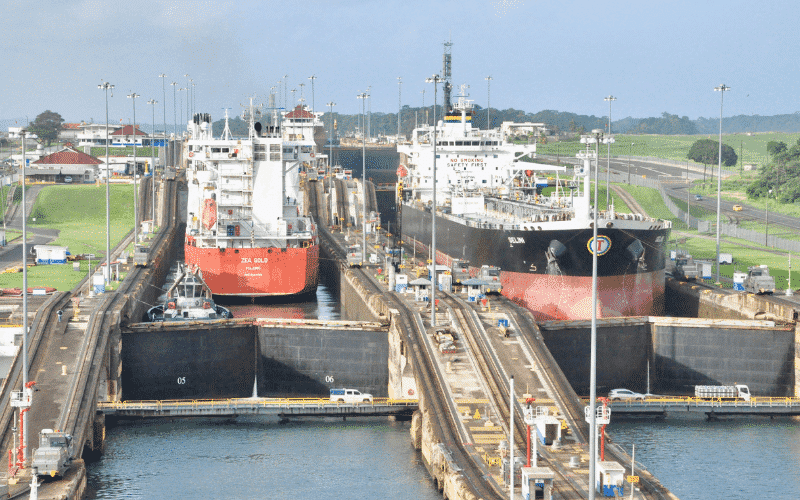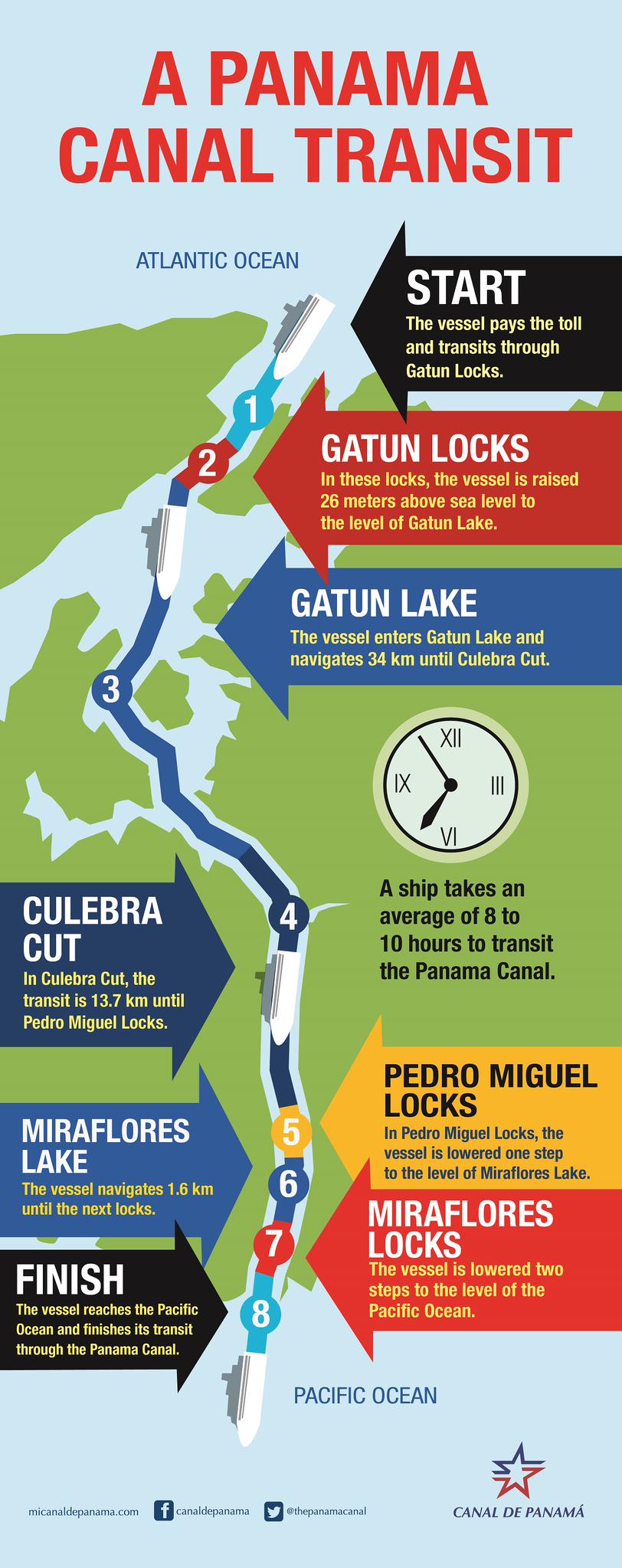

One of the major artificial waterways in the world, Panama Canal connects the Atlantic Ocean and the Pacific Ocean, cutting across the Isthmus of Panama- a narrow strip that separates the Caribbean Sea from the Pacific Ocean.
Completed construction in August 1914, the 77 km-long Panama Canal helps ships sailing between the east and west coasts of the US to shorten their journey by 15,000 km. Similarly, the canal saves up to 3,700 km for vessels transiting between Europe and East Asia.
Currently, the Panama Canal plays a significant role in the US economy since it handles a substantial share of US shipping. In the fiscal year 2017, the canal witnessed the passage of a total of 13,548 vessels, carrying 403.8 million Panama Canal tons of cargo.
Do you know about these interesting facts about the Panama Canal?
Geographically, the oceans that Panama Canal connects with are not at the same level; the Pacific Ocean lies a little higher than the Atlantic Ocean.
This difference in the sea level requires ships to get up over the terrain of Panama- up to 26 meters above sea level- in order to reach the other end of the canal.
With the help of Lock Gates, the vessels entering the canal are lifted to a higher level and later dropped down to the sea level at the other end of the canal.
The Panama Water Lock System is considered to be one of the greatest engineering services undertaken at that time, purporting to the needs of the ships to save transit time.


The Panama Water Lock System consists of a total of three sets of locks-12 locks- to help vessels transit between the Atlantic and the Pacific Oceans via artificial lakes and channels.
Before the canal expansion, which was completed in 2016, the canal had two lines with two sets of the lock at both ends of the canal.
The expansion of the canal resulted in a third lane and a third set of locks that allow the entry of larger vessels.
The locks, located on the Atlantic and the Pacific sides, lift and lower the vessels to/ from the Panama Canal that is situated 26 metres from sea level.
On the Pacific side, the lock system features the two-chambered Miraflores Locks and the one-chambered Pedro Miguel Locks, while the three-chambered Gatun Locks sit on the Atlantic Side of the Panama Canal.
Since these three sets of locks are paired, two parallel flights of locks are located at each of the three lock sites, allowing the simultaneous movement of vessels in opposite directions.
However, in practice, only six massive pairs of locks are used by ships for transit now, and the ships move in one direction at a time due to safety constraints to cross the Culebra Cut.
It also means that the ships currently use both lanes of the lock only to move in one direction at a time.


The original locks of the Panama Canal are 33.53 meters (110 feet) wide, while each lock features a length of 320 meters (1,050 feet). The walls of each lock have a thickness ranges from 15 meters (at the base) to 3 meters (at the top).
The dimensions of the lock decide the size of a ship, which is also known as Panamax- that can pass through the canal. The third set of locks opened after the expansion project allows bigger vessels to cross the canal.
The new Panamax metrics, with the new locks, allows the ships with an overall length of 366 meters, a beam of 49 meters and a draft of 15.2 meters. The total lift, the capacity to raise or lower a vessel, of the locks are; Gatun locks-85 feet, Pedro Miguel locks-54 feet and Miraflores- between 64.5 feet and 43 feet due to the extreme tides.
The gates of the Panama Canal locks separate the champers, and are strong enough to hold thousands of litres of water. The water locks are filled or emptied in less than 10 minutes and each pair of lock gates takes two minutes to open.
The size of the Panama lock gates ranges from 14.33 to 24.99 meters and measures 2.13 meters in thickness. Each gate features two leaves that measure 19.81 meters in width and these leaves are close to a “V” shape with the point upstream, allowing the gates to handle the force of the water.
The gates are only opened when the water level is equal on both sides. A fender chain, weighing around 30,000 pounds, at the end of each lock prevents ships from ramming the gates before they open.
In order to let the vessels pass the lock, each chamber needs to be filled with 26,700,000 US gallons of water. The locks are operated using the gravity flow of water from lakes such as Gatún, Alajuela, and Miraflores.
The lock system includes 18 feet wide water culverts attached to it, performing the duty of carrying water from these lakes to the chambers to raise the vessels and from chambers to the next lock or the sea to lower the vessels.
Operated electrically, the entire process of the lock system is controlled from a control room located on the centre wall of the upper flight of locks.
The control rooms guide the vessels through the lock chambers using electric towing locomotives. Ships are pulled with the help of these machines, called “mules”, using a cable through the locks.
On average, ships require six of such mules, three on each side, when using the locks to enter or exit the canal.
The whole operation of the Panama Water Lock System works can be described in a few steps:
1. The vessel approaches towards the lower chamber of the canal locks;
2. the valve of the first chamber opens and water flows by force of gravity from the higher chamber to the lowest one, bringing the water level to the sea level;
3. the locked gate opens to allow the ship into the chamber, and the gate closes behind it;
4. the valve of the next chamber is opened to increase the water level to that of the first chamber;
5. the gate of the lock is opened and the ship enters the next chamber;
6. The water level is equalized again and the ship finally exits the lock and enters the 77 km long canal.
At the other end of the canal, a similar process will be performed in order to lower the vessel to sea level.
In detail:
For a ship entering the canal from the Atlantic end, travelling in a southeast direction, the first entry will be into the first (sea level) lock chamber located at the Gatun Locks.
After the vessels entered the chamber, the watertight lock doors are closed by the lock-master and the valve is opened to allow the flow of water from the adjacent second lock chamber, 28 feet above sea level.
Water flows through underground pipes into the first chamber until the water levels are equal.
However, no pumps are used here; the entire operation of equalizing the water levels between the locking chambers on the Panama Canal depends on the principles of gravity to move the water and on the fact that water seeks its own level.
When the water levels of two adjacent chambers are equal, the water stops flowing from the water culverts.
Once the water levels between the first and second chamber are the same, the valve gets closed by the lock-master and the watertight lock doors between the first lock chamber and the second lock chamber are opened subsequently.
This process allows the ship to proceed to the second lock chamber. The first operation is repeated then between the second lock chamber and the third lock chamber, which raises the ship to the level of Gatun Lake.
After the closure of the final valve and opening of the watertight lock door, the ship is raised 85 feet above sea level and is able to continue its journey to the Pacific.
The same process inversely is followed in order to send the ship back to sea level. At the Pedro Miguel Locks on the Pacific end of the canal, when the ship enters the first chamber, the watertight doors are closed and the valve gets opened on that lock chamber, allowing water to drain from the first lock chamber into the relatively lower second lock chamber.
After the water level between the two chambers is at the same level, the watertight doors are opened allowing the ship to continue to transmit down the Gaillard Cut to the Miraflores Locks, where the operation of lowering the ship to sea level is completed.
You may also like to read – 4th Engineer’s First Journey Through The Panama Canal
Disclaimer: The authors’ views expressed in this article do not necessarily reflect the views of The Marine Learners. Data and charts, if used, in the article have been sourced from available information and have not been authenticated by any statutory authority. The author and The Marine Learners do not claim it to be accurate nor accept any responsibility for the same. The views constitute only the opinions and do not constitute any guidelines or recommendation on any course of action to be followed by the reader.
The article or images cannot be reproduced, copied, shared or used in any form without the permission of the author and The Marine Learners.










We believe that knowledge is power, and we’re committed to empowering our readers with the information and resources they need to succeed in the merchant navy industry.
Whether you’re looking for advice on career planning, news and analysis, or just want to connect with other aspiring merchant navy applicants, The Marine Learners is the place to be.